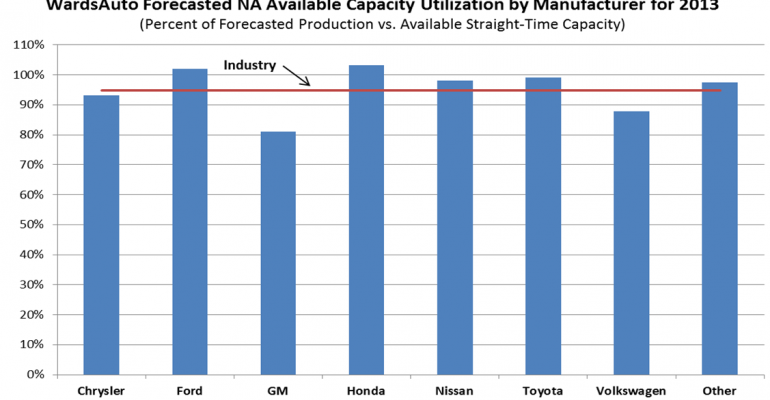North America light-vehicle deliveries are expected to continue climbing for at least the next three years and could outpace supply for several strong-selling models over the next two years.
The magnitude of the shortage will depend on what segments and which vehicle lines are most impacted as consumer demand accelerates, but some auto makers will be capped by capacity constraints while others gain market share by picking up the slack.
Several likely outcomes will be a boost in midsize-car sales and an increase in imports, based on a study of current chokeholds.
WardsAuto data shows North American LV manufacturers have available straight time capacity for 16.9 million vehicles, which includes additional capacity created by plants working 3-shift or 3-crew systems. That stands in stark contrast to the 13.8 million in 2009 during the recession.
Available straight-time production for the third quarter of 4.03 million units is 270,000 more than a year ago and the highest for the period since 2005.
However, there are just 67 plants building LVs compared with 85 in 2005, when output totaled 15.8 million units. WardsAuto/AutomotiveCompass forecasts production at 16.0 million for 2013.
Additionally, output for overseas markets has grown, putting more of a pinch on the supply base for the local market.
Most of the industry appears to be watching for the point at which monthly U.S. sales begin to regularly top the 16 million seasonally adjusted annual rate as an indicator of when to make decisions about major plant expansions.
U.S. auto makers posted a 15.3 million SAAR in the year’s first half and are expected to reach 15.5 million units or more in the last six months. Monthly SAARs could start regularly running at 16 million next year.
There are new plants and expansions coming, but they will have little impact on 2013 and 2014 as most will be for vehicles in the small-size segments that are not in tight supply.
Over the next two years, Honda, Mazda and Nissan are adding factories in Mexico, mostly to build small cars and cross/utility vehicles. Nissan opens its new plant later this year initially for added Sentra production, but the other facilities don’t begin coming on line until next year and won’t make a noticeable impact on supply until 2015.
North American auto makers mostly are in a position of trying to squeeze more out of the factories they have, or sourcing more vehicles from overseas where possible. Almost all are running at high utilization rates and have certain plants or vehicles that are in jeopardy of not keeping up with a market surge.
Ford, Honda and Toyota are feeling the biggest crunch in meeting rising demand. Ford and Honda are on track to build to more than 106% of their available Q3 straight-time output and are expected to finish at more than 100% for the year. Toyota is expected to end the year at 99% of capacity, excluding its assembly line at Subaru’s Lafayette, IN, plant, which is maxed out building Toyota Camrys.
Ford will add a third crew at the end of the third quarter at its Kansas City, MO, No.2 plant where it builds F-150 pickups, giving it seven factories on a 3-crew or 3-shift schedule. The auto maker does have excess capacity at its Flat Rock, MI, joint-venture facility, where it will add overflow Fusion sedan production from Hermosillo, Mexico, at the end of August.
Outside of Flat Rock, Ford has few options in the near term to ramp up capacity if U.S. sales surge past the 16 million-unit level.
Honda plants are bulging in Lincoln, AL; Greensburg, IN; and Alliston, ON, Canada, building trucks and cars. The auto maker opens a new factory in Celaya, Mexico, next year that will produce the Honda Fit and a new B-size CUV. That volume largely will replace imports.
Honda, which sources more than 90% of its North American sales from domestic production, could choose to bump up imports of strong sellers. These include the Civic small car, although its current U.S. inventory is nearly double optimal level, and the CR-V compact CUV, which still has small volumes sourced from Japan.
Toyota could choose to increase overseas sourcing for its small Corolla sedan and RAV4 CUV. The Corolla will launch a redesigned version this fall and demand should rise.
Other major auto makers have more flexibility to increase production through unused capacity and overtime, and are in position to win conquest sales from competitors that can’t meet demand.
General Motors, Chrysler, Nissan and Volkswagen all could gain from lean supplies at Ford, Honda and Toyota.
Among other auto makers, North American plants operated by Korea-based Hyundai and Kia and Japan-based Subaru, are topped out, but all three rely heavily on overseas production to meet local demand, and in theory could increase imports. However, the majority of their overseas products are small cars and CUVs.
Major importer Mazda could benefit greatly, because it has a broader portfolio of small and midsize cars and CUVs to draw from.
Conquest sales most likely will come from the midsize cars, especially if there is a supply shortage in the middle-CUV segment, where models such as the CR-V, RAV4, Chevrolet Equinox, GMC Terrain, Ford Edge and Escape already are tipping capacity scales.
The middle-car segment has a number of newer products, including the new-generation Fusion, Chevrolet Impala and Malibu, Honda Accord, Nissan Altima, Volkswagen Passat and imported Mazda6, that could serve as viable alternatives. Most have capacity to meet a spike in demand.



